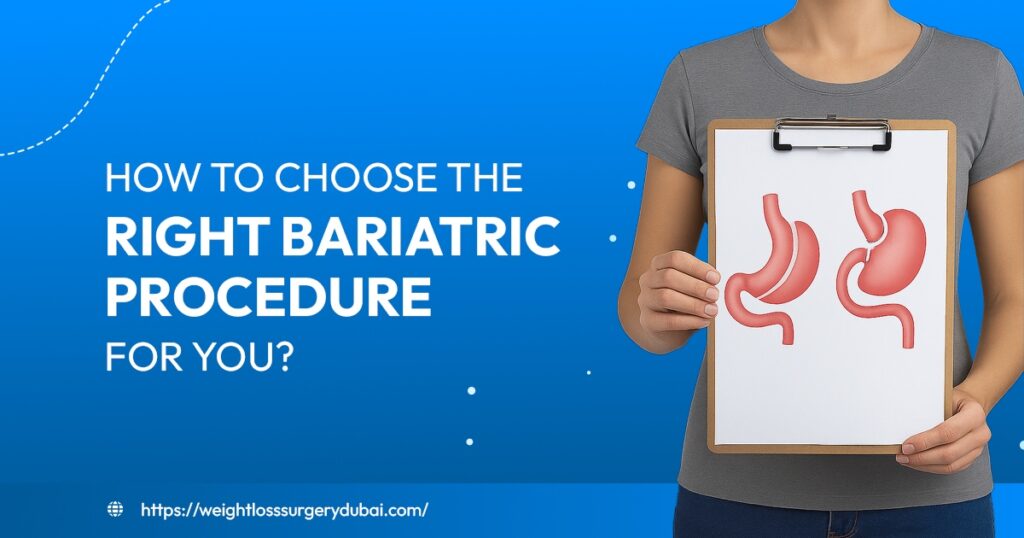
Choosing to undergo bariatric surgery is a life-changing decision—but figuring out which type of surgery is right for you can feel overwhelming. With multiple procedures available—each with unique benefits, risks, and recovery timelines—it’s important to find the one that aligns with your health needs, weight loss goals, and lifestyle.
In this guide, we’ll help you understand the most common types of weight loss surgery, compare them side by side, and share key questions to ask before making your decision.
Why Choosing the Right Surgery Matters
Weight loss surgery isn’t one-size-fits-all. The “right” procedure depends on:
- Your Body Mass Index (BMI)
- Presence of obesity-related conditions like diabetes or sleep apnea
- Your eating habits
- Past weight loss attempts
- Long-term commitment to lifestyle changes
Goal: Find a safe, effective, and sustainable option that fits you—not just the scale.
Types of Weight Loss Surgeries: Pros & Cons
Here’s a quick breakdown of the most common bariatric procedures:
1. Gastric Sleeve (Sleeve Gastrectomy)
- Removes ~70-80% of the stomach, limiting food intake
- Hormonal changes reduce hunger
- Procedure time: 1–2 hours
Pros:
- Simpler than bypass
- Shorter hospital stay
- Effective long-term weight loss
Cons:
- Irreversible
- Potential for acid reflux
Best for: People with BMI ≥ 35, looking for strong results with fewer complications.
2. Gastric Bypass (Roux-en-Y)
- Creates a small stomach pouch and bypasses part of the intestine
- Limits absorption and reduces appetite
Pros:
- Rapid weight loss
- Often resolves diabetes quickly
- Long-term results
Cons:
- More complex procedure
- Risk of nutrient deficiencies
Best for: Patients with diabetes, severe GERD, or BMI ≥ 40.
3. Mini Gastric Bypass
- A shorter, simplified version of Roux-en-Y
- Combines restriction and mild malabsorption
Pros:
- Shorter surgery time
- Good weight loss results
- Lower complication risk vs traditional bypass
Cons:
- Still has risk of malabsorption
- May cause bile reflux
Best for: People seeking similar results to gastric bypass with fewer complications.
4. Gastric Balloon (Non-Surgical Option)
- A temporary balloon is inserted into the stomach to limit food intake
- Removed after 6 months
Pros:
- Non-surgical
- Minimal recovery time
Cons:
- Short-term solution
- Weight regain is common if habits don’t change
Best for: Individuals with BMI 30–35 wanting a jumpstart to weight loss.
Questions to Ask Before Choosing a Weight Loss Surgery
To make the right decision, discuss these questions with your bariatric team:
- What are my weight loss goals?
- Do I have medical conditions like diabetes or GERD?
- Am I okay with a permanent change to my anatomy?
- How committed am I to lifelong dietary and lifestyle changes?
- What are the risks and benefits of each option for me personally?
Quick Comparison Chart
| Procedure | Weight Loss | Recovery | Reversible | Best For |
| Gastric Sleeve | Moderate–High | 2–4 weeks | NO | BMI ≥ 35, fewer complications |
| Gastric Bypass | High | 3–6 weeks | YES | Diabetes, GERD, BMI ≥ 40 |
| Mini Gastric Bypass | High | 2–4 weeks | YES | Need effective results, fewer risks |
| Gastric Balloon | Low–Moderate | 3–7 days | YES | BMI 30–35, prefer non-surgical option |
Final Thoughts: It’s a Personal Choice, Guided by Experts
Choosing the right type of bariatric surgery is a shared decision between you and your medical team. There’s no universally “best” option—only what’s best for your body, your health, and your life goals.
The right surgery is the one that sets you up for safe, sustainable success.
